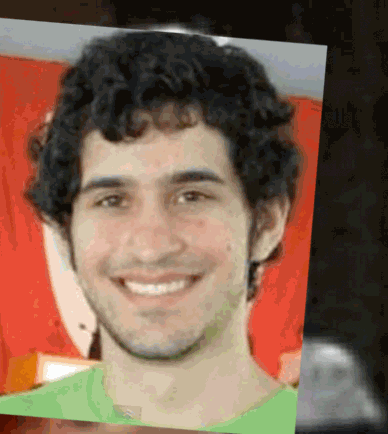How Twitter Wrongfully Accused, Then Cleared Bryn Mawr Man of Boston Bombing

This GIF, showing a Boston bombing suspect morph into Bryn Mawr-born Sunil Tripathi, went viral today
Like many of you, I was up most of the night following the jaw-dropping events in Boston to the best of Twitter’s ability. Between midnight and sunrise, it was a foregone conclusion on Twitter that the Boston Marathon bombing suspect in the White Hat (who, as of the publishing of this post, remains at large, and is considered armed and very dangerous) was Sunil Tripathi, who was born in Bryn Mawr, graduated from Radnor High School, and up until a few weeks ago when he mysteriously disappeared, was a philosophy major at Brown.
As the editor of Phawker.com, a blog that reports and re-distributes the news of the world from a Philly perspective, this was huge: Local boy makes bad, becomes center of a news story that has the eyes and ears not just of the nation but the whole world. Jesus! We gotta post about this! Just one problem, there was no reliable sourcing on this beyond the whisper-down-the-alley of Twitter.
But when the Atlantic reported that the Boston PD was referring to Sunil Tripathi as the bombing suspect in the white hat still at large, I decided to press PUBLISH on a post I’d been assembling pointing out the local connection. Luckily I scoured Twitter one last time before pressing the button, and saw that NBC’s always-dependable Pete Williams was batting down the Sunil connection, citing reliable, high-placed Boston PD sources.
Twitter, it would seem, is no better than the execrable New York Post, which has been a toxic font of wrong information from the moment the bombs went off on Monday. Twelve dead! Saudi suspect in custody! Then came yesterday’s slanderous BAGMEN cover that wrongfully ID’d two young men with backpacks as bombing suspects. Perhaps some hashtag-free soul-searching was in order. Michael Barthel has a must-read piece up on BULLETT questioning the value of following unfolding news events on Twitter and taking the inevitable stomach-churning rollercoaster ride up the hill of fact, only to plunge down to depths of falsehood, over and over. To wit:
The problem I’m concerned with here is less about the people finding and distributing the information. It’s about the people consuming the information, as I was. What good does it do us to follow the story as it unfolds? Certainly some pieces of the information were incredibly useful to Boston-area residents trying to stay safe, but it seemed that local TV stations were on top of the situation from the beginning, and the MIT emergency alert system effectively notified students after the shooting there. Additional Twitter reportage was not necessary, though retweets of the alerts certainly helped as an amplifier—just as word-of-mouth distribution of the information doubtless did as well, even if it was less visible.
But what about me there on the West Coast, checking my Twitter feed as I should have been winding down my day? It felt important to do, somehow. Certainly Twitter kept telling me how important it was, how unique and revolutionary an event it was I was experiencing. But what good did it do me? It may have done me some harm: watching breaking news of traumatic events can actually be harmful to viewers, as one Twitterer pointed out. And what good does it do us as a society? There’s an ideology that says any additional information is good, and that if we just give people more information they’ll be able to better understand the world on their own, untouched by any mediating force. But I’m not sure how I’m any better off knowing a bunch of wrong things that don’t make any sense together. […] Ultimately, I’m not sure what the point is of following breaking news before any solid story emerges.
True, up to a point. By its nature Twitter does encourage itchy trigger fingers because the whole point of Twitter is that it’s instantaneous and everywhere all at once. Twitter encourages the race to be first, because second is meaningless. However, while there was a lot of baseless chatter in the echo chamber last night, there were also credible eyewitnesses to unfolding events providing useful micro-info and people behind the police perimeter providing a fascinating front row view to the action, like this guy who lives right where the initial shootout with the cops that killed the older brother went down and tweeted this pic of their car still sitting in the middle of the street:
The bomb squad has gone through the backpacks #mitshooting #mit #boston twitter.com/AKitz/status/3…
— Andrew Kitzenberg (@AKitz) April 19, 2013
And this shot of a SWAT team going door to door on his street:
Swat is out on laurel st.#mitshooting #boston #mit twitter.com/AKitz/status/3…
— Andrew Kitzenberg (@AKitz) April 19, 2013
And this woman who snapped this insane picture out her back window:
View from my house…crazy #watertown twitter.com/shawna_england…
— Shawna England ⚓ (@shawna_england) April 19, 2013
These are images that the credentialed media never would have gotten and would have been lost forever otherwise—like tears in the rain, as Rutger Hauer says at the end of Blade Runner—but will now be part of the vast archive of visual documentation of this historic event. The larger and more useful point Barthel should be making is not that Twitter is empty data calories and should keep its big fat nose out of the business of “real” reporters, but that people need to use it responsibly, with a healthy dose of skepticism and, like real reporters and editors, consider the source before passing along bad information, and twisting the knife of slander in the hearts of a family already tortured by the mysterious vanishing of their son. There is enough pain and misery in these stories to last several lifetimes; we need not make more.


